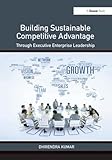Building sustainable competitive advantage : through executive enterprise leadership
By: Kumar, Dhirendra
Material type: BookPublisher: Farnham, Surrey : Gower, c2015.Description: xv, 269 p. : ill. ; 26 cm.ISBN: 9781472470317Subject(s): Total quality management | Leadership | SustainabilityDDC classification: 658.4/092
BookPublisher: Farnham, Surrey : Gower, c2015.Description: xv, 269 p. : ill. ; 26 cm.ISBN: 9781472470317Subject(s): Total quality management | Leadership | SustainabilityDDC classification: 658.4/092 | Item type | Home library | Call number | Status | Date due | Barcode | Item holds |
|---|---|---|---|---|---|---|
| REGULAR | University of Wollongong in Dubai Main Collection | 658.4092 KU BU (Browse shelf) | Available | T0054551 |
, Shelving location: Main Collection Close shelf browser
Includes bibliographical references (p. 233-260) and index.
Shows how the Enterprise Excellence (EE) philosophy is a holistic approach for leading an enterprise to total excellence. This title focuses on achieving sustainable significant growth in revenue and profitability, reducing the business cycle time, strategically managing the enterprise risk and focusing on the needs of the customer.
""Cover""; ""Contents""; ""List of Figures""; ""List of Tables""; ""About the Author""; ""List of Abbreviations""; ""Introduction""; ""1 Enterprise Excellence Model""; ""1.1 Historical Enterprise Excellence Models""; ""1.2 Excellence Models? Evergreen Characteristics""; ""1.3 Development of the Enterprise Excellence (EE) Model""; ""2 Enterprise Growth Strategy (EGS)""; ""2.1 Business Vision and Mission""; ""2.2 Innovative Growth Ideas""; ""2.3 Market Growth Strategy""; ""2.4 Core Competency""; ""3 Enterprise Risk Management (ERM)""; ""3.1 ERM ? Introduction and Definition"" ""3.2 Why ERM is Important""""3.3 ERM through Strategic Risk Management (SRM) and Holistic Risk Management (HRM)""; ""3.4 ERM through Integrated Risk Management (IRM)""; ""3.5 Risk Areas""; ""3.6 Characteristic Forces and Quantifying Risk""; ""3.7 Risk Management Guidelines""; ""4 Enterprise Transformation (ET)""; ""4.1 Enterprise Assessment Process""; ""4.2 Elements of Enterprise Transformation, Why and How It Happens""; ""4.3 Mobility and Social Networks in Enterprise Transformation""; ""4.4 Financial Transformation Initiatives""; ""4.5 Workforce Transformation"" ""4.6 Environmental Transformation""""4.7 Safety and Security Transformation""; ""4.8 ET Case Studies""; ""5 Strategy Execution and Measurement""; ""5.1 Strategy Execution Approaches""; ""5.2 Elements Impact on Strategy Execution""; ""5.3 The Balanced Scorecard Concept""; ""5.4 Measurement of the Executed Strategy""; ""5.5 Strategy Derailment and Failure""; ""5.6 Enterprise Excellence Model Summary: Chapters 1?5""; ""6 Enterprise Excellence Case Studies""; ""6.1 Case Study of Two Commercial Airplane Businesses""; ""6.2 Case Study of Three Aerospace Manufacturing Companies""; ""APPENDIX"".






